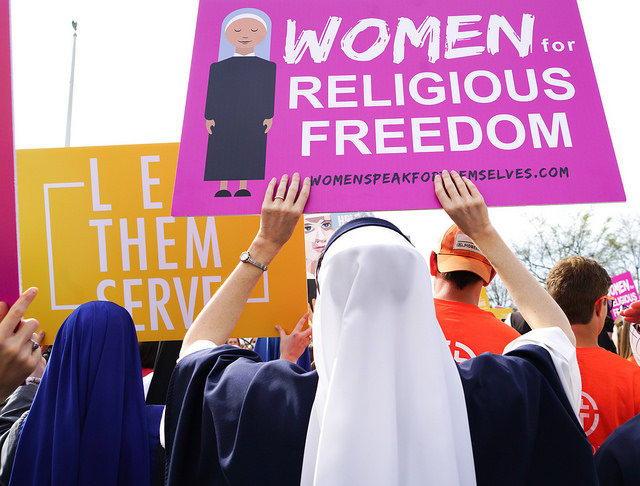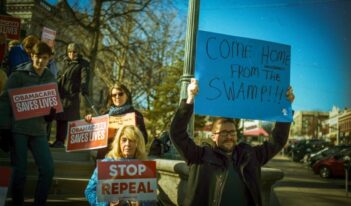
Zubik v. Burwell highlights thorny issues surrounding Obamacare’s contraceptive coverage requirement.
Zubik v. Burwell was this year’s Affordable Care Act (ACA) appearance on the Supreme Court stage. Consolidated with six other cases, Zubik challenged the ACA requirement that group health plans and health insurance issuers must provide free coverage of preventative services, including all contraceptive methods approved by the U.S. Food and Drug Administration (FDA).
Some religious groups believe that the use of some or all contraceptives is morally wrong. In response, the initial preventive services regulation exempted houses of worship, such as churches, from the requirement altogether. For religious nonprofit organizations, such as universities and hospitals, later regulations created an accommodation that enabled employees to receive coverage for contraceptives without the employer having to provide it.
Even though the U.S. Department of Health and Human Services (HHS) has tried to make it easy for nonprofit organizations to receive the accommodation, it still requires those organizations, unlike churches and other houses of worship, to ask for it affirmatively through a process of self-certification.
The petitioners in Zubik—religious nonprofit organizations that provide employee health insurance—challenged this accommodation as violating their religious liberty as protected by the Religious Freedom Restoration Act (RFRA), seeking instead to be included in the exemption afforded churches and other houses of worship. RFRA requires that when federal regulations substantially burden a person’s exercise of religion, the government must use the least restrictive means of furthering a compelling government interest.
This case follows a related 2014 decision in Burwell v. Hobby Lobby, where the Supreme Court held that the contraceptive coverage requirement violated the religious freedom of closely-held corporations whose owners had religious objections to it. Critical to this decision was the fact that requiring coverage as part of the employer plan was not the least restrictive means to achieve the government’s goal. There was an obviously less restrictive approach: the very accommodation the government allowed for religious nonprofits that two years later became the subject of Zubik.
The petitioners in Zubik argued that HHS’s requirement that nonprofit organizations seeking accommodation must notify HHS or an insurer in order to receive the accommodation made them morally complicit in the provision of contraceptive coverage and substantially burdened their religious freedom.
In oral arguments, the petitioners argued that the regulations “hijacked” their employer plans—a position incompatible with the fact that the government regulates employer plans and benefits in myriad ways. The petitioners even suggested that it might be unacceptable if the same insurance company that provided the employee health insurance had any role in providing contraceptive coverage.
Thus, the petitioners posed a less restrictive, yet clearly politically infeasible, alternative: government-provided contraception-only plans.
In response to the petitioners’ arguments, the government emphasized that the accommodation procedures served a compelling governmental interest in providing seamless coverage for contraceptive care and that the accommodation provided the least restrictive means of achieving this coverage.
After the oral arguments, it seemed possible the Supreme Court would divide 4-4 on the case. But this past spring, the case took an unusual turn. The Court requested supplemental briefs from the parties, seemingly looking for compromise on a less-restrictive alternative to achieve the goal of seamless coverage.
The Court’s order directed the parties “to address whether and how contraceptive coverage may be obtained by petitioners’ employees through petitioners’ insurance companies, but in a way that does not require any involvement of petitioners beyond their own decision to provide health insurance without contraceptive coverage to their employees.”
In their supplemental brief, the petitioners wrote that they would gladly not comply with the requirement and their noncompliance could be a signal to insurers to provide coverage through a completely separate policy.
In their brief, the government replied that most of the elements of the compromise the Court suggested were already in the final rule for insured plans—those where an employer buys policies for its employees from an insurance company who pays for claims—including that the objecting employer would not pay for coverage and that coverage would be provided separately from the employer’s health plan. However, the government’s brief also emphasized that the self-certification process was minimally intrusive in all circumstances and legally required in the case of self-insured plans, which are plans where the employer, rather than the insurer, pays for the health claims for its employees and an insurer or other organization may act as an administrator for the plan that the employer has designed and funds, but does not act as a risk-bearing entity (i.e., insurer).
This distinction is important because for insured plans, there might indeed be potential for a less-restrictive solution because if the employer does not cover contraception, the insurer will know this and can provide the coverage instead. But in a self-funded plan, the employer acts as the insurer. Theoretically, the plan’s third-party administrator could step in, but under the Employee Retirement Income Security Act (ERISA), the government must first designate it as a “plan administrator.” HHS’s original self-certification form was designed to provide such legal designation, but it requires the employer to sign on the dotted line. At the very least, the government would need to be aware of an employer’s objection and the identity of the plan’s third-party administrator to affect the designation. This means that in the case of self-funded plans, the least restrictive alternative requires some notice. (An employer could, of course, change to a fully-insured plan or a self-funded church plan, which the government conceded would be exempted, if the employer wished to avoid having to provide such notice.)
Following supplemental findings, the Supreme Court decided that the parties had the potential to reach a compromise without its substantive intervention. The Court vacated and returned the case to the lower courts in a unanimous per curium opinion that declined to rule on the merits. This opinion avoided a 4-4 split that would have left the lower court decisions standing but the legality of the contraception coverage requirement unanswered.
Yet, the Court’s hope for compromise might go unanswered. The reply supplemental briefs by the petitioners and the government sounded more like battle hymns than kumbaya. They still disagree on the role a nonprofit can be required to play in triggering accommodation in some cases and also on the substance of the accommodation itself.
The petitioners envisioned that insurers would issue a standalone contraceptive-care-only insurance policy with separate opt-in enrollment. The government countered that this vision was practically and legally impossible and that the petitioners only offered this proposal knowing its impracticality. The government conceded that self-certification might not be necessary for insured plans but insisted on its necessity for self-funded plans, which constitute the majority of employee-health plans.
The supplemental briefs crystalized the nub of disagreement. If petitioners could choose not to comply, they would not object to completely separate coverage for their employees. But they also said that requiring any record of religious objection beyond simple noncompliance constitutes a substantial burden because it makes them complicit in enabling the insurer or the third-party administrator to provide contraception.
In light of the petitioners’ position, it seems the government should have pressed harder on what is a substantial burden under RFRA. Is signing a name on a form or calling HHS to indicate a religious objection really a substantial burden on religious liberty? Even after being prompted by Justice Kennedy during oral arguments, former Solicitor General of the United States Donald Verrilli did not question the legal fact of a substantial burden on petitioners’ religious exercise.
It is quite possible that the government will have another bite at the “substantial burden” apple when the Supreme Court’s hoped for compromise falls short, which could mean this issue returns to the Supreme Court for resolution on its merits.
Zubik illuminates the moral aspect of health insurance. Health insurance serves to spread health care costs. Anything covered by a plan is financed equally by all members of the plan (and by the employer too, arguably, in an employer plan). When the law mandates coverage of a benefit, such as contraception, it affirms the social value of this benefit. To make the mandated benefit equally accessible to all women, regardless of need or ability to pay, it must be financed collectively. However, the same good that the ACA has deemed socially valuable, the petitioners see as a moral wrong. The well-worn moral battles over contraception and abortion thus continue to play out.
This essay is part of The Regulatory Review’s seven-part series, The Supreme Court’s 2015 Regulatory Term.
The image of Supreme Court demonstrators is the property of the Victoria Pickering and is used under a Creative Commons License.




